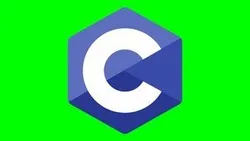
C Programming: Modular Programming and Memory Management - 3 
Learn the fundamentals of C programming, including modular programming and memory management, with this comprehensive course. Gain the skills necessary to become a proficient C programmer. ▼
ADVERTISEMENT
Course Feature
![]() Cost:
Cost:
Free
![]() Provider:
Provider:
Coursera
![]() Certificate:
Certificate:
Paid Certification
![]() Language:
Language:
English
![]() Start Date:
Start Date:
29th May, 2023
Course Overview
❗The content presented here is sourced directly from Coursera platform. For comprehensive course details, including enrollment information, simply click on the 'Go to class' link on our website.
Updated in [April 29th, 2023]
This course, C Programming: Modular Programming and Memory Management - 3, is designed to help students enhance their coding skills and become proficient C programmers. Students will learn the essential concepts of functions and pointers, which are foundational to any programming language. Through this course, students will gain insight into a computer's architecture and learn how its memory is organized. Pointers, which are often considered the most difficult part of C programming, will be introduced with novel and innovative visualization tools. By the end of this course, students will have reached the third milestone in the C Programming with Linux Specialization program, unlocking the door to a career in computer engineering. This course has received financial support from the Patrick & Lina Drahi Foundation.
[Applications]
The application of this course can be seen in various industries, such as scientific computing and data science, embedded systems, robotics, IoT, and more. By the end of this course, learners will have gained the essential concepts of functions and pointers, which are foundational to any programming language. This knowledge can be used to develop programs and applications for various industries, as well as to pursue a career in computer engineering.
[Career Paths]
Recommended career paths for learners of this course include:
1. Programmer/Developer: Programmers and developers use C programming to create software applications, websites, and other digital products. They are responsible for writing, testing, and debugging code, as well as designing and implementing software solutions. As the demand for software applications continues to grow, the need for skilled programmers and developers is expected to increase.
2. Embedded Systems Engineer: Embedded systems engineers use C programming to develop embedded systems, such as those used in transportation, utility networks, and aerospace. They are responsible for designing, developing, and testing embedded systems, as well as troubleshooting and debugging any issues that arise. With the increasing demand for embedded systems, the need for skilled embedded systems engineers is expected to grow.
3. Robotics Engineer: Robotics engineers use C programming to develop robots and robotic systems. They are responsible for designing, developing, and testing robots, as well as troubleshooting and debugging any issues that arise. With the increasing demand for robots and robotic systems, the need for skilled robotics engineers is expected to grow.
4. IoT Engineer: IoT engineers use C programming to develop Internet of Things (IoT) solutions, such as those used in smart homes, automation, and wearables. They are responsible for designing, developing, and testing IoT solutions, as well as troubleshooting and debugging any issues that arise. With the increasing demand for IoT solutions, the need for skilled IoT engineers is expected to grow.
[Education Paths]
Recommended Degree Paths:
1. Bachelor of Science in Computer Science: This degree program provides students with a comprehensive understanding of computer science fundamentals, including programming, software engineering, computer architecture, and operating systems. It also covers topics such as artificial intelligence, machine learning, and data science. This degree is ideal for those looking to pursue a career in software engineering, computer programming, or data science.
2. Master of Science in Computer Science: This degree program provides students with an advanced understanding of computer science fundamentals, including programming, software engineering, computer architecture, and operating systems. It also covers topics such as artificial intelligence, machine learning, and data science. This degree is ideal for those looking to pursue a career in software engineering, computer programming, or data science.
3. Master of Science in Artificial Intelligence: This degree program provides students with an in-depth understanding of artificial intelligence and its applications. It covers topics such as machine learning, natural language processing, computer vision, and robotics. This degree is ideal for those looking to pursue a career in artificial intelligence, machine learning, or data science.
4. Doctor of Philosophy in Computer Science: This degree program provides students with an advanced understanding of computer science fundamentals, including programming, software engineering, computer architecture, and operating systems. It also covers topics such as artificial intelligence, machine learning, and data science. This degree is ideal for those looking to pursue a career in research or academia.
Developing Trends:
1. Cloud Computing: Cloud computing is becoming increasingly popular as a way to store and access data. This technology is being used to create more efficient and cost-effective solutions for businesses and organizations.
2. Big Data: Big data is becoming increasingly important in the world of computer science. This technology is being used to analyze large amounts of data and uncover insights that can be used to make better decisions.
3. Machine Learning: Machine learning is becoming increasingly popular as a way to automate tasks and make decisions. This technology is being used to create more efficient and accurate solutions for businesses and organizations.
4. Internet of Things: The Internet of Things (IoT) is becoming increasingly popular as a way to connect devices and systems. This technology is being used to create more efficient and secure solutions for businesses and organizations.
Pros & Cons

Quality teaching and learning environment

Concepts of pointer explained well

Good balance between practice

quizzes

and lecture videos

Best group of C language courses

Very good explanation of pointers

Excellent learning experience

No way to control video speed

Software a little buggy and awkward to use
Course Provider

Provider Coursera's Stats at AZClass
Discussion and Reviews
0.0 (Based on 0 reviews)
Explore Similar Online Courses

Database Design

Packaging Applications with Helm for Kubernetes

Python for Informatics: Exploring Information

Social Network Analysis

Introduction to Systematic Review and Meta-Analysis

The Analytics Edge

DCO042 - Python For Informatics

Causal Diagrams: Draw Your Assumptions Before Your Conclusions

Whole genome sequencing of bacterial genomes - tools and applications

Learn C Programming Using the Classic Book by Kernighan and Ritchie

C - Fast Crash Course - Introduction


Start your review of C Programming: Modular Programming and Memory Management - 3